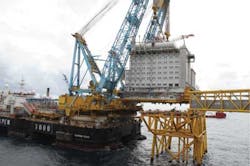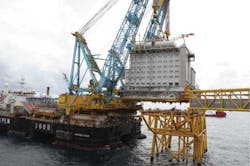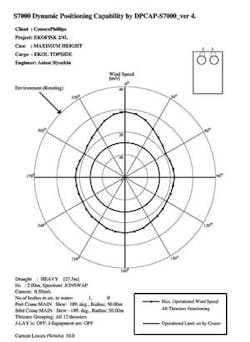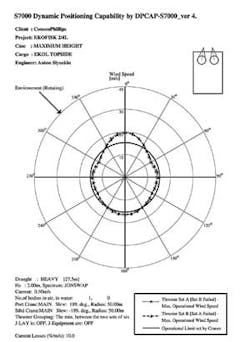Careful planning precedes successful platform installation at Ekofisk
Stig Minsaas
RC Consultants
Stuart Paterson
Saipem Ltd.
Vikrant Joshi
Gaurang Haldipur
ConocoPhillips
The Ekofisk field, operated by ConocoPhillips Norway, is located in the southern part of theNorwegian North Sea. The field has been in operation for more than 40 years. The Ekofisk complex comprises nine platforms and bridge connections. The newest platforms are the wellhead platform 2/4Z and the field center and accommodation platform 2/4L, which were installed in 2013.
Since the development started early in the 1970s, the complex has been a field center and hub for the production from the Ekofisk field itself, and from the other fields in the Greater Ekofisk area. In addition, production from other fields in the area is transported via theEkofisk complex to the receiving terminals in Emden, Germany, (gas) and Teesside, UK (oil).
Upon hook-up and commissioning in 1Q 2014, the2/4L accommodation platform will be the new field center, replacing all functions presently located at the aging 2/4H and 2/4Q platforms. The platform has a total accommodation capacity of 552 single occupancy cabins, and will be the world's largest offshore living quarters platform and serve as a safe haven for the Ekofisk complex. It will also provide office space, storage areas, workshops, an emergency center, fire water supply, and telecommunications controls for the Ekofisk complex.
The 2/4L topside facilities were engineered and constructed under an EPC contract awarded to SMOE Pte. Ltd. The transportation and installation execution scope was awarded to Saipem UK Ltd. in 2010. The topsides were successfully installed on top of the jacket in August 2013. The jacket and the bridge structures connecting 2/4L to the Ekofisk complex were installed in 2012.
The topsides weighed more than 11,200 metric tons during offshore installation, representing one of the heaviest offshore lifts using dynamic positioning (DP) by theSaipem 7000 installation vessel. Due to high lift weight, tight clearances, and environmental conditions, an extensive engineering and planning effort was carried out to ensure a safe and successful offshore installation campaign. This included:
Setting up installation constraints/limits
Installation limitations in both lift weight and dimensions were established for the installation of the 2/4L topside. These limitations were based on the lifting capabilities of theSaipem 7000 (S7000) by way of both capacities of the cranes, their geometry, and resulting clearances to the topsides module at all stages throughout the lifting operation.
An initial installation study checked the lift configuration and clearances during preparation and lift-off from the transport vessel and at hover over the jacket prior to set-down. From this study, exclusion zones were developed. No structure, equipment, fixture, or fitting was allowed to extend into this area during the offshore lifting operation. These exclusion zones were modeled into the designer's PDMS model of the topside, and the designers of all disciplines were made aware that no items were to encroach beyond this boundary. This ensured that no damage or hindrance was experienced during the installation.
The exclusion zones were based on nominal clearances of 5.0 m (16 ft) to theS7000 at lift-off and during setting of the topsides. Two conditions were considered. For the case just before lift-off from the transport vessel, clearances were critical to the hull structure of the S7000 up to the upper deck, corresponding to topsides levels 0 to 3. For the hover over the jacket, a minimum clearance of 1.5 m (4.9 ft) under the topside stabbing cones was assumed, with the S7000 at operation draught of 27.5 m (90.2 ft) and using sea level at LAT. In this condition, clearances to the crane boom were critical.
An additional case considered was to cover clearance for the tail swing of theS7000 cranes with the transport vessel and topside moored across the S7000 bow. For this case an allowance for 2° of transport vessel roll and a further minimum 3 m (10 ft) clearance was considered.
Topside lift rigging design factors
Due to the weight of the deck, it was agreed with the marine warranty surveyor (MWS) that reduced lifting factors would be used for the rigging calculations to improve the capacity ofS7000 for the lift. The rigging was constructed from high strength steel wire, reducing the weight of the rigging and increasing the allowable weight of the topside.
At a minimum lift radius of 50 m (164 ft), each crane had a static hook capacity of 6,000 metric tons in tied back mode. East/west center of gravity (COG) zone/envelope of 1.75 m (5.74 ft) offset from the center of lift points. The topside was designed with four lift trunnions; each hook of the crane connected to two lift points. Rigging used for the lift was newly purchased.
Tilt was controlled by the relative levels of theS7000 crane hooks. Grommet lengths were selected to suit the most likely COG. Grommet lengths were selected on the basis of minimum allowable angle of 70°.
The following lift design factors were applied within the rigging design:
- Weighing inaccuracy: 1.015
- COG envelope inaccuracy: 1.01
- Transverse tilt: 1.01
- Yaw factor: 1.05
- Dynamic amplification factor: 1.10.
The chosen lift rigging was:
- Doubled grommet 287 mm diameter, 133.09 m long, 39.8 metric ton weight and CGBL (calculated grommet braking load) of 7,344 metric tons (2 each)
- Doubled grommet 287 mm diameter, 130.74 m long, 39.1 metric ton weight and CGBL of 7,344 metric tons (2 each).
The weighing inaccuracy factor was reduced further to 1.01, with agreement from both Saipem and the MWS, upon receipt of the weighed weight report from SMOE, to gain extra capacity to allow the lift to be performed without the need for additional weight shedding apart from the helideck. As a condition of this reduction, a strict policing program was implemented at the fabrication yard prior to sail-away.
S7000 DP capability analysis
The DP capability analysis is a tool used to derive wind speed limits for the installation. The windage area of each module goes into Saipem's in-house program, and given other fixed environmental criteria, a study defines a limiting wind speed. The limiting wind speeds were based on the following assumptions:
- Topside lifted on the main hooks of both cranes at the point of highest lift
- Fixed current velocity of 0.5 m/s uniform with depth
- Intact case and worst case failures
- Significant wave height of 2.0 m (JONSWAP wave spectrum formula)
- Wind, wave, and current co-directional
- Ballast to heavy lift draught
- Both port and starboard cranes with lift radius of 50 m, slew angle of 188.56°
- IMCA specifications for DP capability plots
- Horizontal forces and yaw moments due to wind on the lifted item calculated from the projected area and center of pressure
- Wind load calculations on the topside considers shape coefficient of 1.0 and simple cuboid shape
- Sensitivity analysis was carried out for
- a. Crane radius change of +/- 6 m horizontally and +/- 3 m vertically
- b. COG of +/- 6 m radially and +/-3 m vertically
- c. Equivalent crane boom radius and slew angles considered.
The intact results showed that the DP system provided sufficient capacity to withstand wind speeds much more than the limit for the crane operations (30 knots).
For the worst failure case at approximate headings of 60° and 300° (with respect to the bow ofS7000), the maximum allowable wind drops to below the crane operability limits. This was considered acceptable due to the small probability that this wind speed would be exceeded during the proposed installation months.
The study also showed that the limiting wind speed does not vary significantly with the change in crane radii and COG movement. This analysis ensured that the operations were safe with regards to station-keeping capabilities of the vessel.
Displaying 1/2 Page 1,2, Next>
View Article as Single page




